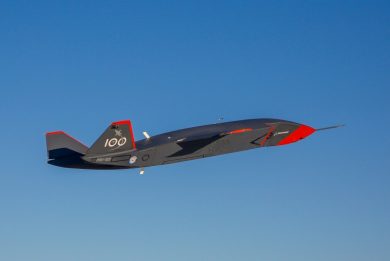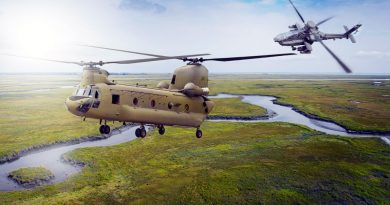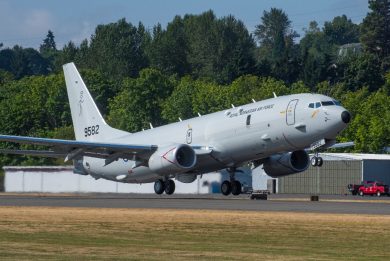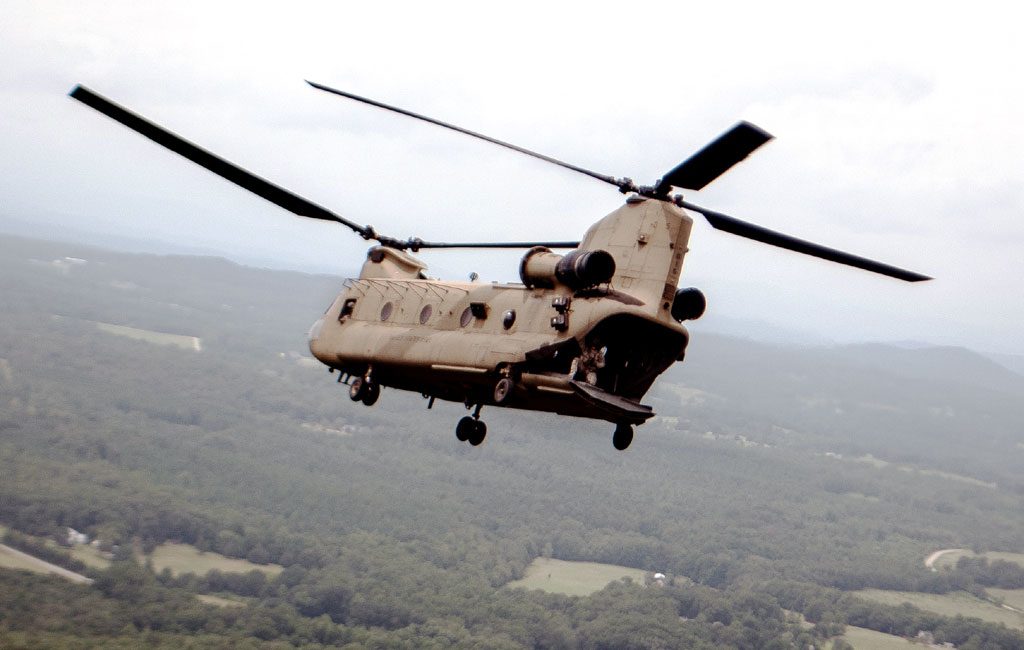
Chinook: a never ending story
It is in Building 3-61.1 on the Philadelphia Boeing facility, home of the vertical lift, that the half-century old but constantly updated two-rotor Chinook is assembled. And the very latest iteration of this worldwide operating helicopter was visible on the shortest assembly line in the building, made of only three stations and kept for special productions, such as the first Block II Chinooks. In mid-May the third Block II produced for the EMD (Engineering & Manufacturing Development) phase was visible on the line; the first one was flying at the company Mesa facility, where Boeing carries out most of its flight testing as the weather allows flight ops 350 days per year. It fist took off on 26 March this year, “one month ahead of schedule” Boeing officials highlight proudly, although it was not yet in the full configuration, the blades being the original ones and not the ones developed for the new version. EMD Block II number 2 was in the painting phase during our visit, and was going to fly soon to Mesa. As for that on the assembly line, once ready it will fly to Naval Air Station Patuxent River, Maryland, where an anechoic chamber for electromagnetic compatibility testing is available.
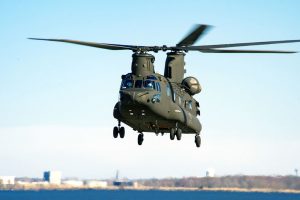
The H-47 Block II EMD phase is fully funded until 2021. “The aim of the programme is to bring back the Chinook to its original payload, 4,000 lb of which were eroded by the helicopter weight increase due to the add-on of multiple systems and armour,” Chuck Dabundo, VP Cargo and Utility Helicopter Programs and H-47 Program Manager explains. Block II helicopters will have a wholly new airframe, with a considerable growth potential. From the outside the main difference will be the front landing gear moved forward, ahead of the right side front window. This allows to host between the front and rear landing gears a single fuel tank, instead of the three tanks that the “F” model inherited from the original Chinook. Splitting the fuel tank in three allowed to better control the fuel flow, thus the centre of gravity; however more than 50 years have elapsed since the Chinook first flight, and new technologies allow dealing with the fuel flow even in a single long tank; this allows to get rid of all hoses and pumps that linked the three elements, saving weight and space for hosting more fuel. The other distinguishing feature of Block II Chinooks will be the longer nose which extra space allows containing more black boxes, making the F Block II similar to current G-models as well as to the latest UK Chinooks, and the new blade, known as ACRB (Advanced Chinook Rotor Blade); the requirement was for the two rotors to provide 1,500 lb extra lift however, according to Boeing, tests proved that the increase will be of over 1,700 lb.
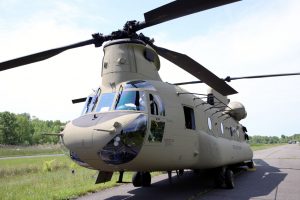
“The key year for the Block II programme will be 2021, when the EMD programme will finish leading to Milestone C, when the Army will decide if and how many of its CH-47F will undergo the Block II upgrade,” Dabundo says; this might in fact be called a re-building considering the new airframe and blades. What has been already decided is the upgrade of all 69 MH-47G deployed by the US Army Special Operations Aviation Command (USASOC). “A fist contract for the upgrade of eight helicopters has already been signed, and Boeing was awaiting a second one for seven further Chinooks, the USASOC programme keeping the lines busy until 2024,” Dabundo states.
As said, the new airframe has been designed with some growth potential, among which the adoption of a new and more powerful engine, which will obviously bring with it a new transmission. “Since 2016 Boeing, General Electric and the US Army worked on a possible solution and a demonstrator will fly before year-end with two GE T408 turbines in place of current Honeywell T55-GA-714A,” Dabundo announces. While the latter provide 4,868 shp each, the GE turbines can provide up to 7,500 shp, however the demonstrator will be fitted with the standard transmission thus the engines will be trimmed to a much lower power, the aim being to verify technical issues, such as vibrations, using a new turbine. Should the programme get financed, currently it is not, the upgraded helicopters would also receive a reinforced transmission fitted with a torque management system, to avoid overtorque, as well as the APAS (Active Parallel Actuator System).
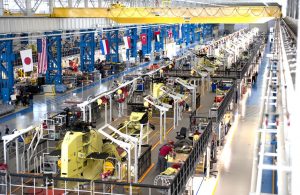
Coming back to the current production, it is worth describing the assembly line of Building 3-61.1. The building itself was the object of major renovation, an investment plan started in the early decade having led to considerable improvements in most production lines in Philadelphia, that of the Chinook having received additional 133 million US$ in the last two years to make it what it looks now, being laid out according to the lean manufacturing concept. Beside the aforementioned three-station line currently used for assembling the first Block IIs, two other lines, each with nine stations, are hosted in the building. “The main line is used for assembling US Army CH-47F and export helicopters very similar to the standard US configuration,” Randy Rotte, Director Cargo Helicopters and Future Vertical Lift illustrates. It is here that the shorter Takt Time can be reached, down to four days per push, although at the moment of our visit it was of 10 days. On these nine stations the helicopter goes from the naked airframe to the complete helicopter; leakage test comes next, followed by painting and then blades are installed leading to company test flights. We took part in one of those, but a warning light interrupted it, leading to a precautionary landing on the Old Mans Airport close to Pedricktown, New Jersey. With less than 10 hours motion on its log book, the CH-47F meant for the US Army suffered the typical transmission teething problem, gears adapting to each other generating small metal particles immediately spotted by the sensors that led to the lighting of the warning signal in the cockpit. A problem solved in a short time, but sufficient to avoid us to enjoy the manoeuvres that the Boeing test crew wanted to perform.
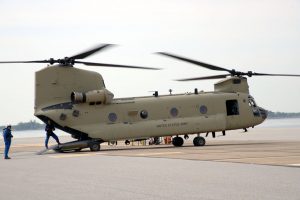
“The second line is used for the assembly of helicopter with evolved configurations, typically USASOC MH-47Gs,” Rotte says. Numerous export Chinooks were also assembled on that line, such as those aimed at the United Kingdom and Canada, while during our visit Indian CH-47s were being assembled there. Takt Time here is obviously higher, complexity and diversity requiring more labour. “Between 2012 and 2018 310 aircraft were manufactured, the average production rate being now of 36 helicopters per year, this data varying depending on demand,” Chuck Dabundo says, highlighting 2015 as a record year with 59 H-47 delivered. In June the line will host the first Singaporean CH-47F, while soon Chinooks with Spanish marking should appear, this country having decided to upgrade its D-model helicopters to the Foxtrot standard.
With over 950 H-47 flying in 20 countries, the two rotors helicopter is aiming at a possible retirement date around 2060, which will put it close to one century from its first flight on 21 September 1961. This means that the Chinook has some 40 more years ahead of it, and in the R&D department Boeing engineers are looking at new functions, mostly to reduce pilot’s workload: increased autonomous flight capabilities, such as automatic take off and landing, degraded visual environment modes with embedded obstacle avoidance, are only a few of those being currently considered.
Photos courtesy Boeing and by Paolo Valpolini

